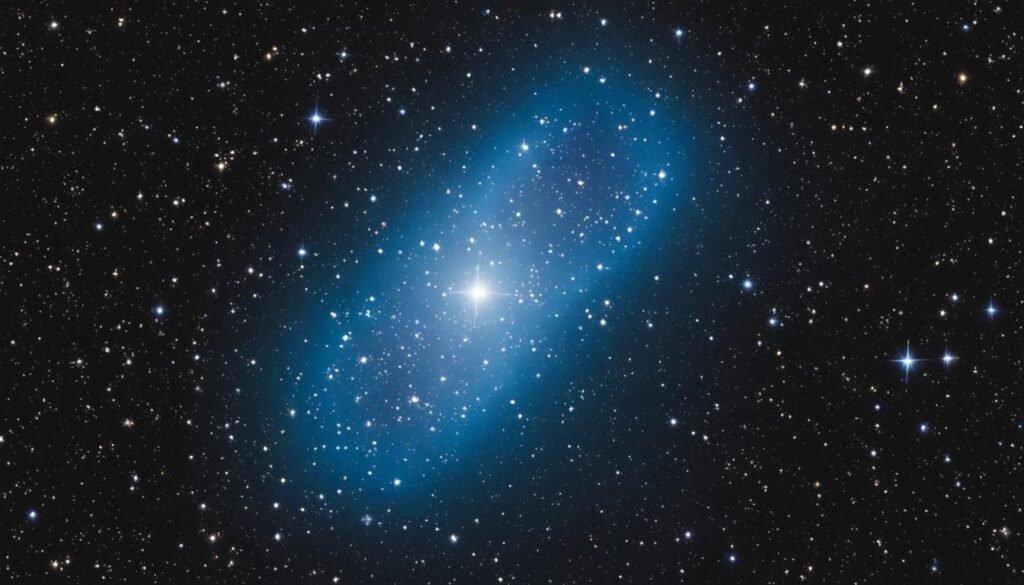| Genitive | |
| Abbreviation | |
| Pronunciation | |
| Main Stars | |
| Brightest Star | |
| Right Ascension | |
| Declination | |
| Sq. Deg. Area | |
| Crosses Meridian | |
| Visible Lat. Range |
Welcome to the celestial journey through the stars where you’ll discover the Constellation Gemini, a beacon in the night sky that has guided humanity for millennia. You might be familiar with the constellation’s representation in horoscopes, but the tales and truths of Gemini extend far beyond what meets the eye. Gemini constellation facts are as rich and vibrant as the stars that compose its shape, revealing a multitude of secrets waiting to be uncovered.
With a history that harks back to the ancient world, the constellation is not only significant for its place in mythology but also for its role in the evolution of astronomical study. Named after the Latin “the twins,” Gemini paints an illustrious tapestry that connects us with our past. As you gaze upon the two main stars, Castor and Pollux, know that you’re witnessing the very Gemini characteristics that bring to life a legendary saga written among the stars.
Key Takeaways
- Unveil the stories behind the Constellation Gemini, linking celestial wonder to mythological narratives.
- Learn fascinating Gemini constellation facts, including its historical significance and astronomical relevance.
- Discover the Gemini characteristics through its brightest stars and their connections to ancient tales.
- Explore the night sky with a newfound appreciation for Gemini’s role in the zodiac and its influence on astrology.
- Recognize the twin stars Castor and Pollux as more than just luminous points, but as symbols of mythological importance.
- Prepare for a celestial experience that connects the stars of Gemini to their storied past and astronomical significance.
A Stargazer’s Introduction to Constellation Gemini
Embarking on a celestial journey through the stars, you’ve undoubtedly encountered the Gemini zodiac sign
Gemini astrological sign is not simply a cluster of stars—it’s a gateway to understanding the ancients’ view of the cosmos and an illustration of the cosmic dance that unfolds overhead.
The Position and Significance of Gemini in the Zodiac Family
As you gaze up at the night sky, the constellation Gemini greets you from its stronghold in the Zodiac family. This constellation has been a fixture of stargazing since ancient times when Ptolemy first laid eyes on its twin beacons. Your Gemini horoscope draws from the dynamic narrative of these stars, providing insights woven from celestial alignments. Spread between latitudes +90° and -60°, it maintains a cosmic camaraderie with neighbors Auriga, Taurus, and Cancer, proudly regaling the stellar tales of its ancient roots.
Twin Stars of Gemini: Castor and Pollux
In the realm of the constellation Gemini, two luminous guides stand out—the twin stars of Castor and Pollux, named after the famed Dioscuri of Gemini mythology. These celestial siblings offer a beacon of light to navigators of the night. Pollux, with its orange glow, ranks as the 17th brightest star, marking the presence of a giant star. Together with Castor, a complex sextuple star system, they showcase the wondrous variety that the cosmos holds.
Mythological Roots: From the Dioscuri to the Patron Saints of Sailors
The story of the Gemini twins is not solely confined to the ink-black canvas above. From the tales of their divine parentage—Leda’s union with both Zeus and King Tyndareus—to their brotherly bond and skills in combat, these heroes have sailed from the scrolls of Greek mythology straight into the stars. As the patron saints of sailors, they became emblems of protection, said to summon St. Elmo’s fire to guide and guard seafarers on treacherous waters. Amidst the Gemini star sign, their legend continues to inspire and captivate those who look to the heavens.
| Star | Brightness Rank | Star Type | Role in Mythology |
|---|---|---|---|
| Pollux (β Geminorum) | 17th | Evolved Orange Giant | Son of Zeus, immortal twin |
| Castor (α Geminorum) | 44th | Sextuple Star System | Son of Tyndareus, mortal twin |
Exploring the Brightest Stars in Gemini’s Night Sky
As you gaze into the depths of the night sky, the constellation of Gemini offers an illuminating display with its most luminescent stars, Pollux and Castor. These celestial beacons serve as a gateway to understanding the richer aspects of the cosmos. Not only are they known for their brilliance, but they also rank among the brightest stars in Gemini, offering a captivating narrative to anyone transfixed by the wonders above.
The twin stars are diverse in their characteristics, with Pollux bestowing a warm, orange glow that is the result of its evolved nature. Castor, though appearing singular to the naked eye, is a complex system that demands a closer look. Observing these stars becomes more than a pastime; it is an exploration into the life cycles and interactions that define our universe.
| Name | Designation | Color | Apparent Magnitude | Distance from Earth (light-years) | Star System Type |
|---|---|---|---|---|---|
| Pollux | β Geminorum | Orange Giant | 1.14 | 33.78 | Single |
| Castor | α Geminorum | White | 1.58 (combined) | 51 | Sextuple |
| Alhena | γ Geminorum | Blue-White | 1.93 | 109 | Binary |
| Mebsuta | ε Geminorum | Yellow Supergiant | 3.06 | 840 | Single |
The fine details presented in this stellar lineup provide not just a visual treat, but an educational journey, as each star holds its unique life story. By exploring the vivid tableau presented by Gemini’s stars, we gain insights into the dynamic universe we are a part of. Remember, when observing the majestic night sky, the shining duo of Pollux and Castor is your enduring guide through the celestial wonders of Gemini.
Deep Sky Wonders: Clusters and Nebulae within Constellation Gemini
As your eyes wander through the Gemini constellation, beyond the twinkling radiance of the twin stars Castor and Pollux, you will stumble upon cosmic scenery that seems to have been painted onto the fabric of the night sky itself. These deep-sky attractions within Gemini’s celestial boundaries are a testament to the beauty and wonder that the universe holds. In particular, the open cluster known as Messier 35 is a sparkling jewel in Gemini’s crown.
Revealing the Splendor of the Messier 35 Open Cluster
While the stars of Gemini tell ancient tales, the open cluster Messier 35 (M35, NGC 2168) offers a visual portal to more recent cosmic history. Dispersing light across space for over 2,800 light-years, M35’s stars appear intimately connected, celebrating their shared origin. Binoculars under a clear night sky reveal its distinct presence, akin in size to the full moon, yet distant and delicate. It exists as a gleaming congregation of stars, a beacon within the **Gemini constellation** signaling the splendor of celestial gatherings.

Hidden Gems: Exploring Lesser-Known Deep Sky Objects in Gemini
Your exploration of the **Gemini constellation facts** also leads you to cosmic enigmas such as the Medusa Nebula—a planetary nebula whose tangled webs of gas betray its turbulent origin. In the quieter corners of Gemini, objects like the Eskimo Nebula and the Jellyfish Nebula are cosmic spectacles that amateur astronomers desire to capture with their telescopes. The waltz of luminous clusters and ghostly **nebulae in Gemini** creates a stargazing symphony that rewards the curious observer with awe-inspiring views.
| Deep Sky Object | Designation | Distance (Light-years) | Apparent Magnitude | Observation Notes |
|---|---|---|---|---|
| Messier 35 | NGC 2168 | 2,800 | 5.2 | A rich open cluster visible with binoculars |
| Medusa Nebula | Sharpless 2-274 | 1,500 | 15.99 | Planetary nebula with a complex structure |
| Eskimo Nebula | NGC 2392 | 2,870 | 9.1 | Resembles a face surrounded by a fur parka |
| Jellyfish Nebula | IC 443 | 5,000 | Varies | A supernova remnant with filamentous features |
Whether you’re tracing the outline of the **Gemini constellation** or delving into the intricate details of the **Medusa Nebula**, each visible through stellar patience and a keen eye, your journey through the night sky’s marvels is rich with discovery. Witnessing these cosmic wonders, you contribute your own verse to the enduring legacy of skywatching, an ode to the eternal dance of the heavens.
The Dynamic Duo: Castor and Pollux in Myth and Astronomy
When you gaze up at the night sky and spot the constellation Gemini, you’re observing more than just a cluster of stars—you’re peering into an astronomical legacy steeped in Gemini mythology. Known for their historical and cultural significance, the twins Castor and Pollux have captured the imaginations of civilizations for centuries.

Ancient Interpretations of the Gemini Twins
The narrative of the Gemini twins stretches far back into antiquity, with their stories intricately woven into the very essence of the constellation Gemini. In Greek mythology, they were seen as protectors and companions, while in Babylonian lore, they took on the mantle of gods Meshlamtaea and Lugalirra. The duality and Gemini characteristics they represent are as multifaceted as the stars themselves. Their journey from revered mythological figures to timeless celestial markers underscores their enduring presence in the cultural consciousness.
Understanding the Unique Stellar Makeup of Gemini’s Twin Stars
The Gemini twin stars, despite their shared story, differ remarkably in their astral composition. Castor appears as a single point of light, deceiving the casual observer. Closer examination reveals an intricate sextuple star system—an elegant ballet of stellar bodies intertwining in space. Conversely, Pollux shines with the steady glow of an evolved orange giant, its maturity marked by the presence of a known extrasolar planet in orbit.
| Star Name | Type | Key Features |
|---|---|---|
| Castor | Sextuple Star System | Comprises multiple binary stars; complex gravitational interplay |
| Pollux | Orange Giant | Hosts an extrasolar planet; exudes a ruddy brilliance |
Together, Castor and Pollux serve as cosmic emblems of the life cycle of stars, where youth and age coexist in a celestial dance. Through your understanding of the intricate nature of Gemini’s twin luminaries, you deepen your connection to the cosmos and grasp the profound symbolism they hold within the shimmering expanse above.
Constellation Gemini’s Role in Modern Astronomy and Culture
When you gaze up at the night sky, the stars of Constellation Gemini are more than just twinkling lights from a distance; they’ve become integral to both modern astronomy and the cultural tapestry of society. The gifts of Gemini extend well beyond its presence as a celestial marker, influencing diverse areas such as astrology and space exploration. For countless individuals, the Gemini horoscope provides daily insights shaped by the stars, intertwining ancient astrological traditions with contemporary life. This enduring interest in the celestial twins of Gemini reveals our deep connection to the cosmos and its perceived impact on personal destiny.
Embarking on a foray into the history of space travel, you’ll discover that Project Gemini left an indelible mark on the progress of human exploration beyond Earth’s atmosphere. This pivotal NASA program of the mid-1960s, named after the constellation, was instrumental in developing the spaceflight techniques that led to the awe-inspiring moon landings. Project Gemini stands as a testament to humans harnessing the inspirational power of the stars to fuel their quests into the unknown and challenge the very boundaries of human capability. The name Gemini, thus, captures the duality of historical achievements and aspirational dreams stitched into the fabric of our exploration narratives.
Moreover, the Geminids meteor shower, originating from this star system, annually adorns the December skies with a dazzling spectacle of celestial fireworks. This extraordinary display, derived from Constellation Gemini, contributes to our collective wonder, inspiring astronomers, and sky enthusiasts alike. As you reflect on these connections, you’ll recognize that the Gemini constellation isn’t just a cluster of distant suns—it’s a symbol of human curiosity, a bridge between science and mythology, and a beacon that has guided our intellectual and cultural voyages for millennia.
FAQ
What is the constellation Gemini and why is it significant?
The constellation Gemini, named after “the twins” in Latin, is one of the 88 modern constellations and holds a significant place in the zodiac family. Associated with the mythological twins Castor and Pollux, Gemini is rich in astrophysical features such as bright twin stars, neutron stars, and deep sky objects, making it a focal point for skywatchers and astronomers. It is also an important part of horoscopic traditions, contributing to the narratives of Gemini astrological sign.
How can I locate the Gemini constellation in the sky?
The constellation Gemini can be found in the northern celestial hemisphere, positioned in the second quadrant (NQ2), and is best visible at latitudes between +90° and -60°. Look for its two brightest stars, Castor and Pollux, which form the heads of the mythological twins, near neighboring constellations Auriga, Cancer, and Taurus. Gemini’s presence in the zodiac sky is marked from late June to late July.
Who were Castor and Pollux in mythology, and how do they relate to the constellation Gemini?
Castor and Pollux, also known as the Dioscuri, are the mythological twins associated with the constellation Gemini. They were the sons of Leda and both Zeus and King Tyndareus of Sparta in Greek mythology. They are celebrated for their brotherly devotion and martial prowess and were revered as protector figures among sailors. Their mythical legacy is represented by the two brightest stars in the Gemini constellation, and they symbolize protection and companionship.
What are the brightest stars in the constellation Gemini?
The brightest stars in the constellation Gemini are Pollux (β Geminorum) and Castor (α Geminorum). Pollux is the brighter of the two, an evolved orange giant star, and ranks as the 17th brightest star in the night sky. Castor is the second-brightest in Gemini, forming a complex sextuple star system, and holds the position of the 44th brightest star. Together, these twin stars are prominent features in the constellation.
What deep sky objects are within the constellation Gemini?
Constellation Gemini hosts a rich array of deep sky objects. Notably, it contains Messier 35 (M35), an open cluster easily observed under clear skies with binoculars. Other fascinating objects within Gemini include the Eskimo Nebula (NGC 2392), Jellyfish Nebula, and the Medusa Nebula, each offering unique perspectives and stories for stargazers and astrophotographers.
Are there any unique features about the twin stars Castor and Pollux in Gemini?
Yes, Castor and Pollux are intriguing both mythologically and astronomically. Castor, although it appears as a single star to the naked eye, is actually a sextuple star system that comprises a complex arrangement of stars in binary groups. Pollux, on the other hand, is an orange giant that even harbors an extrasolar planet in its orbit. This stellar duo represents the breadth of star life cycles and the diversity of structures within the galaxy.
How does the constellation Gemini influence modern astronomy and culture?
Constellation Gemini influences both scientific inquiry and cultural expression. In modern astronomy, it contributes to how horoscopes are interpreted through the Gemini astrological sign and has been pivotal in namesake missions like NASA’s Project Gemini. Culturally, Gemini features in various mythologies and is the source of the Geminids meteor shower, showcasing the constellation’s deep-rooted impact on our relationship with the cosmos.






